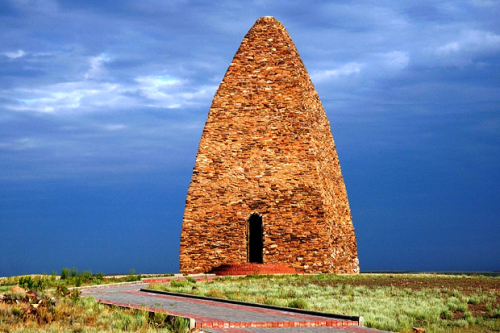
The mausoleum Mazar Kozy-Korpesh and Bayan Sulu (X-XI centuries) is situated in Ayagoz district of East Kazakhstan in 7 km. to the Southwest from Tarlauly village, on the right bank of the Ayaguz river, in 11 km. to the West from the station Tansyk. Mazar is a tomb of a saint man among the Muslims.
Mazar is connected to the names of the heroes from the lyrical epic poem, and is one of the ancient monuments of Kazakhstan that is extant today with some view changes. The image of these heroes of the folklore is the symbol of eternal love between young man and girl, the Kazakh Romeo and Juliet. Kozy-Korpesh and Bayan Sulu is the most widespread lyrical poem of the Kazakh people. The first notes of one variant were written for Pushkin and were kept in his archives. At the end of the last century the famous researcher in Central Asia and Kazakhstan, Potanin G.N. wrote: “… The favorite story, which is known from Orenburg to Zaysa, top of the Kazakh ethics, is the story of beautiful Bayan Sulu, who fell in love with Kozy-Korpesh…” The worried story about the tragic love, transmitted over the centuries by word of mouth, and now comparative with the famous love story of Romeo and Juliet, passed through several editions in the Kazakh and Russian languages.
The high of the tomb is 11,65 m., walls’ thick is 1,86 m. The entrance in the East has small windows of 0,7×0,5 cm. Before the entrance four sculptures are set, according to the people’s legends they depict Kozy-Korpesh, Bayan Sulu, her small sister and daughter-in-law.
At first the volume composition of the tomb with the square plan (7,1×7,1 m. - from outer side, 3,38×3,38 m. – from inner side) was a four-sided pyramid formed by feeding the horizontal rows of masonry and topped with the shaped spire.
In 1982 Mazar Kozy-Korpesh and Bayan Sulu was included to the list of historical and cultural monuments of the Kazakh SSR and was taken under the protection of the government.


